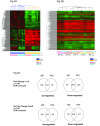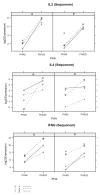Differential gene expression profiles are dependent upon method of peripheral blood collection and RNA isolation
- PMID: 18847473
- PMCID: PMC2573897
- DOI: 10.1186/1471-2164-9-474
Differential gene expression profiles are dependent upon method of peripheral blood collection and RNA isolation
Abstract
Background: RNA isolation and purification steps greatly influence the results of gene expression profiling. There are two commercially available products for whole blood RNA collection, PAXgene and Tempus blood collection tubes, and each comes with their own RNA purification method. In both systems the blood is immediately lysed when collected into the tube and RNA stabilized using proprietary reagents. Both systems enable minimal blood handling procedures thus minimizing the risk of inducing changes in gene expression through blood handling or processing. Because the RNA purification steps could influence the total RNA pool, we examined the impact of RNA isolation, using the PAXgene or Tempus method, on gene expression profiles.
Results: Using microarrays as readout of RNA from stimulated whole blood we found a common set of expressed transcripts in RNA samples from either PAXgene or Tempus. However, we also found several to be uniquely expressed depending on the type of collection tube, suggesting that RNA purification methods impact results of differential gene expression profiling. Specifically, transcripts for several known PHA-inducible genes, including IFNgamma, IL13, IL2, IL3, and IL4 were found to be upregulated in stimulated vs. control samples when RNA was isolated using the ABI Tempus method, but not using the PAXgene method (p < 0.01, FDR corrected). Sequenom Quantiative Gene Expression (QGE) (SanDiego, CA) measures confirmed IL2, IL4 and IFNgamma up-regulation in Tempus purified RNA from PHA stimulated cells while only IL2 was up-regulated using PAXgene purified (p < 0.05).
Conclusion: Here, we demonstrate that peripheral blood RNA isolation methods can critically impact differential expression results, particularly in the clinical setting where fold-change differences are typically small and there is inherent variability within biological cohorts. A modified method based upon the Tempus system was found to provide high yield, good post-hybridization array quality, low variability in expression measures and was shown to produce differential expression results consistent with the predicted immunologic effects of PHA stimulation.
Figures




References
-
- Thach DC, Lin B, Walter E, Kruzelock R, Rowley RK, Tibbetts C, et al. Assessment of two methods for handling blood in collection tubes with RNA stabilizing agent for surveillance of gene expression profiles with high density microarrays. J Immunol Methods. 2003;283:269–279. doi: 10.1016/j.jim.2003.10.004. - DOI - PubMed
-
- Rainen L, Oelmueller U, Jurgensen S, Wyrich R, Ballas C, Schram J, et al. Stabilization of mRNA expression in whole blood samples. Clin Chem. 2002;48:1883–1890. - PubMed
Publication types
MeSH terms
Substances
LinkOut - more resources
Full Text Sources
Other Literature Sources
Molecular Biology Databases
Miscellaneous

